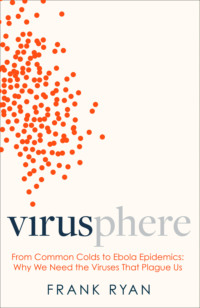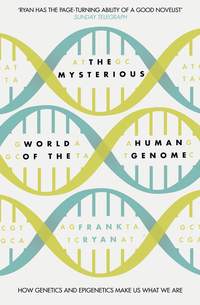
Полная версия
Virolution

FRANK RYAN
Virolution
The most important evolutionary book since Dawkins’ Selfish Gene

Copyright
William Collins An imprint of HarperCollinsPublishers 1 London Bridge Street London SE1 9GF
www.harpercollins.co.uk
First published by Collins 2009
Text & diagrams © FPR-Books Ltd 2009
Frank Ryan asserts his moral right to be identified
as the author of this work.
A catalogue record for this book is available from the British Library.
All rights reserved under International and Pan-American Copyright Conventions. By payment of the required fees, you have been granted the nonexclusive, nontransferable right to access and read the text of this e-book on-screen. No part of this text may be reproduced, transmitted, decompiled, reverse-engineered, or stored in or introduced into any information storage and retrieval system, in any form or by any means, whether electronic or mechanical, now known or hereinafter invented, without the express written permission of HarperCollins e-books.
HarperCollinsPublishers has made every reasonable effort to ensure that any picture content and written content in this ebook has been included or removed in accordance with the contractual and technological constraints in operation at the time of publication.
Source ISBN: 9780007315123
Ebook Edition © JULY 2013 ISBN: 9780007545278
Version: 2018–12–04
To the memory of Terry Yates, for the courtesyand generosity of his help and the inspirationthat gave rise to this life-changing journey.
Science knows no country because it is the light that illuminates the world.
LOUIS PASTEUR
Like science, emerging viruses know no country. There are no barriers to prevent their migration across international boundaries or around the 24 time zones.
RICHARD M KRAUSE
A relatively small number of investigators have been preoccupied with the biology of viruses … and how they tick; these scientists are more sensitive to the … evolution of their symbiotic relations with their hosts.
JOSHUA LEDERBERG1
Contents
Cover
Title Page
Copyright
Dedication
Epigraph
Introduction: A Wind of Change
1: An Enigma from the World of Plagues
2: A Crisis in Darwinism
3: The Genetic Web of Life
4: The AIDS Dimension
5: The Paradox of the Human Genome
6: How Viruses Helped Make Us Human
7: The Implications for Medicine
8: The Autoimmune Diseases
9: Cancer
10: The Wider Dimension
11: Sex in the Evolutionary Tree
12: Are We Polyploid?
13: The Genie that Controls the Genes
14: The Coming Epiphany
15: At Journey’s End
Glossary of Terms
Index
Acknowledgements
About the Author
References
About the Publisher
Introduction
A Wind of Change
I am quite sure that our views on evolution would be very different had biologists studied genetics and natural selection before and not after most of them were convinced evolution had occurred.
JBS HALDANE1
In the opening line of his celebrated book, The Ascent of Man, Jacob Bronowski declared that ‘man is a singular creature. He has a set of gifts which make him unique among the animals.’ Putting aside the now outmoded sexual conventions implicit in his terminology, our natural instinct is to believe he was right. Surely we humans are unique. We are unique in recognising, at sentient level, our own existence. We have risen above the other animals in the landscape so that, for good or for bad, we now shape and control that landscape. But does this intellectual uniqueness mean that we are so radically different that we should be set apart from all other life in our evolutionary origins, which have governed the very nature of our beings?
When, on 12 February 2001, two rival organisations announced simultaneously that they had completed the first comprehensive analysis of the human genome, surely this would have confirmed any such purported uniqueness of our human nature. Here, laid bare, for the first time in our history, was the complete library of our genes, the make-up of the 46 chromosomes that make us human. Alas, of any purported uniqueness it registered little. Nevertheless, it was remarkable for what it did reveal.
The first surprise was the modest size of the human genome, at about 20,000 genes. We had anticipated that our human complexity would have demanded 100,000, or more. To put it into perspective, we have only ten times as many genes as a bacterium, a third more than a fruit fly and not many more than a nematode worm. It seems that, at least in quantity of genomic memory, we are not vastly more complex than these humble life forms, though our genome is far more complex in the way we convert genes to proteins, so we can code for a great many more proteins with the same number of genes. Most revealing of all was the confirmation of our common inheritance with other forms of life on Earth. For example, we share 2,758 of our genes with the fruit fly, 2,031 with the nematode worm – indeed, all three of us, human, fly, and worm, have 1,523 genes in common.
While some of my readers might feel humbled by this news, I suspect that Darwin would have been exhilarated because he would have realised that this shared inheritance could not have arisen by chance. We are familiar with the extreme accuracy of genetics in forensic science where a small piece of genetic coding can prove that a certain individual, and nobody else, committed a crime. To have 1,523 whole genes in common is rather more conclusive evidence – I could not even begin to calculate the order of the odds of this happening by chance, whether billions or trillions to one. And this touches upon the reasons why evolutionary biology is among the most fascinating and important of the sciences, and indeed generally of human endeavours: it alone seeks, through the application of logic and experiment, to understand the origins of life, from its beginnings in such humble and terrible surroundings as existed on our newborn planet, to the beautiful and beguiling diversity we see on our fecund blue world today.
There are other great mysteries in the universe, for example in the forces of astronomy and in the minuscule yet equally wonderful world of particle physics, yet no other scientific study sets out to explain how, for example, we shapers-of-the-landscape came to be. The religiously devout may disagree, in attributing life to the creation of an omnipotent creator, but this viewpoint does not derive from science but from the application of faith. In my view, religion and science are based on different belief systems, and they ask quite different questions of those belief systems, so that little is to be gained in such comparative argument. But in one respect I will highlight an aspect I believe to be important. Creationists, including those proposing the anti-evolutionary philosophy of intelligent design, will proclaim that evolution is based upon a theory – Darwin’s concept of natural selection – so that, ultimately, the reality of evolution cannot be taken as proven. From this perspective, natural selection will never be capable of absolute proof, since a theory is a construct in logic, not fact. This view prevails among creationists in spite of the fact that scientists have subjected natural selection to remorseless experiment for some 150 years, and it has emerged ever victorious. Yet even here, at the very heart of such passion and division, I believe that a broader perspective is emerging, which is part and parcel of the wind of change blowing through evolutionary biology, and this is capable of offering the hard and irrefutable evidence needed.
Evolutionary theory has profound implications for society, as can be seen in the broad and diverse literature relating it to the humanities. Take the statement of the distinguished French biologist, Jacques Monod, who shared the Nobel Prize with fellow Frenchman, François Jacob, for work on the way living organisms control the production of proteins from their coding genes. In his book, Chance and Necessity, he made the telling statement … ‘Even today a good many distinguished minds seem unable to accept or even to understand that from a source of noise natural selection could quite unaided have drawn all the music of the biospheres.’ Monod’s book was published in 1970, ironically coinciding with first publication of the pioneering views of Lynn Margulis on the critical importance of symbiosis in the origin of nucleated cells, and of Susumu Ohno on the inevitability of gene and genomic duplication in the origin of animals and plants.
I’m an admirer of Monod and his contribution to biology. But in evolutionary terms his viewpoint was exclusively reductionist and selectionist. Like most of his contemporaries, he believed that evolution took place through the action of natural selection on a single source of genetic change, mutation. Since the contribution of mutation was essentially random, its role was non-creative – he even uses the term “informationless”. This is what he refers to as “noise”, a metaphor for random genetic change comparable to the static one hears on a radio. Only when the meaningless static – the random mutations – are moulded by natural selection, does meaningful sound emerge. I very much doubt that anybody has ever captured the zeitgeist of Modern Darwinism better. It is a seductive argument, beautifully amenable to the mathematical extrapolations of calculus in analysing selective fitness and population dynamics. How could it be wrong?
In fact it was not wrong – it was simply a part, and not the remarkable whole, of the story. The humanities have been heavily swayed by such reductionist thinking, which is often, if understandably, misquoted as “nihilistic” in the rebuffs of angry creationists. In this book I shall paint a very different perspective of evolution than selection working on informationless noise. The core message of this book is that mutation – what Monod has so brilliantly conceptualised – is not the exclusive source of genetic, or, for that matter, genomic variation. It is my intention to prove, from an entirely scientific standpoint, that natural selection alone could not have given rise to the evolution of life, and its subsequent diversity, for it depends on a number of driving forces, each of which is an important source of hereditable genetic change, and without which selection would achieve nothing. Great evolutionary forces, such as symbiosis and hybridisation, are of vital importance to the variation that Darwin so desperately needed, and they invoke a creativity that is very different from, and far more powerful than, meaningless static. Indeed, they bring to their respective genomic unions novel combinations of meaningful pre-formed genes, to create virgin genomes with enhanced potential for survival. Our understanding of these other forces of evolution has been growing over the last decade or two, until, today, we can see that they too have played, and are still playing, important roles that taken together are equal with, and essentially complementary to, natural selection. This important and rapidly growing field of knowledge has never been drawn to public attention. In this book I shall show how these various driving forces are not theory but fact, which can be confirmed and thus proven with the tools of modern science – indeed, they can be confirmed, repeatedly and predictably, with far greater certainty than that of the forensic scientist with his or her DNA confirmation of guilt or innocence.
Through this new window of exploration, I shall set out to prove beyond all reasonable doubt that evolution is real and ongoing.
The most astonishing implication of this new perspective is the light it throws on our own human evolution, which is proving to be stranger, a mystery more fantastic than anybody could have predicted even a generation ago. Moreover, the new evolution is eminently practical, not only for the light it sheds on our human origins but also for the real understanding it offers in terms of our embryological development, our physiology, genetics and internal chemistry. This is of great personal interest to me, both as a physician and as an evolutionary biologist, since it brings into focus key lines of research and thinking I have been developing over the course of many years. In the world of modern medicine, with its growing understanding at the molecular level and its increasing potential for genetic therapy, we need to know how our normal genes work as part of the machinery of the nucleus and its component chromosomes, which, all added together, make up the complex whole of our human genome. To know this is to deconstruct the mechanisms that made it. How else can we achieve this other than through understanding the mystery of our human evolution?
In Virolution I invite you to accompany me on rather an unusual journey – a new and, I believe, highly original exploration of the genetic and genomic forces that constructed our human genome. For me, as a doctor as well as an evolutionary biologist, it has been gratifying to discover major new implications for medicine along this journey, insights that offer important understanding of the genetic underpinning of a great many important and common diseases, including cancer, the autoimmune diseases, multiple sclerosis, and mental illnesses, such as schizophrenia. Indeed, for me the journey also has an additional personal interest, one that began with a more conventional, if harrowing, interest in the nature of plagues, but which, thanks to the inspiration and assistance of informed colleagues, led me to follow new lines of scientific investigation and then to propose some relevant ideas of my own. I hope you will enjoy the vignettes about how this happened and that you will find the new ideas stimulating in themselves as well as helpful to understanding. Welcome then to an exciting odyssey, one you may find exotic, even a little scary at times, but at journey’s end I believe that you will be thrilled, and perhaps even a little awed, by the powerful forces that made us, and that are still actively working within us, as we continue to evolve as a species.
1
An Enigma from the World of Plagues
A man can learn wisdom even from a foe.
ARISTOPHANES1
Elysia chlorotica is a beautiful leaf-shaped sea slug that inhabits the salt marshes of the eastern seaboard of the United States, from Nova Scotia in the far north to the warmer waters of coastal Florida in the far south. As the name implies, it is a semi-transparent emerald-green colour and it swims with elegant undulations of its gold-hemmed skirts, which, in biological fact, are the frilly extensions of its slug-style foot. The colour also signals a mystery, for Elysia is one of the “plant-animals”, aptly named by the English botanist, Frederick Keeble, at the turn of the nineteenth century – creatures that really do embody the living features of plants and animals.2 Yet Elysia ’s mystery lies deeper still, for in this exotic and beautiful creature we encounter a more profound enigma, one that is both terrible and enlightening. To appreciate the mystery, we need to visit Elysia in its coastal habitat and examine its very curious life cycle.
Life for the hermaphroditic slug begins as the first warmth of spring rouses it from the torpor of winter. Only now will it lay its egg masses into the brackish water, where, a week or so later, they hatch out as larvae. The larvae spend the next few weeks swimming here and there in the planktonic layers of the coastal marshes, all the while searching for the green filaments of a single species of seaweed, the alga Vaucheria litorea, to which they home and firmly attach. Having found the right alga, they complete their metamorphosis to tiny slugs, when they immediately begin to feed, rasping through the algal walls and sucking out the contents of its cells. Vaucheria is a green alga, which, like the green leaves of trees, is packed with tiny bun-shaped organelles, known as chloroplasts, which capture the bountiful energy of sunlight. This process, known as photosynthesis, is fundamental to the cycles of life, enabling plants to convert sunlight into chemical energy that can be stored, and further shared, by the animals that feed on plants. In essence, all of the familiar life forms we see around us depend on photosynthesis, without which our world would be a very different place. There would be no oxygen in the atmosphere, no trees or flowering plants, no fish to swim in the oceans, and no birds, mammals or people.
Photosynthesis began perhaps as long ago as 3 billion years, when some early bacteria, known as cyanobacteria from their blue-green colour, evolved on our exceedingly young, and volatile, planet. A good deal later, through the evolutionary process known as symbiosis, these pioneering photosynthetic microbes were incorporated into early nucleated life forms, formerly known as protozoa but today called protists, which became the forerunners of the green algae and plants. But the cyanobacterial forerunners never went away. They still thrive in the planktonic regions of the oceans, and their ancestral forms also survive, though somewhat whittled down in their genomes, within the tissues of algae and plants as the tiny cellular inclusions known as chloroplasts. All of Elysia ’s rasping and sucking are directed at these chloroplasts, which it somehow separates out from the other contents of the algal cells, before secreting them away into special cells lining its gut. Soon the gut expands, branching out into various tiny channels all over the body of the growing slug, so that the precious chloroplasts end up in a confluent layer immediately beneath its skin. Thus replete, the slug abandons its mouth to become exclusively solar-powered for the remainder of its life, deriving all of the energy it needs from the algal chloroplasts, which, like a myriad fairy lights within its leaf-shaped body, have switched on the illumination and turned it green.
However, we are far from done with the Elysian mystery. The ingested chloroplasts must now continue to gather the energy of sunlight throughout the slug’s life, and this in turn would normally rely on a continuous supply of proteins, which would be coded by the algal nucleus. How then, since the chloroplasts are no longer connected to the algal nucleus, do they continue to survive and function throughout the nine months of the slug’s day-to-day life cycle?
In fact, we now know that, at some time during the previous evolution of Elysia chlorotica, key genes have been transferred from the nucleus of the alga to the nucleus of the slug.3 Much remains to be discovered about this natural genetic engineering, but there is gathering evidence that it is made possible by viruses that inhabit the slug’s nucleus and tissues. One very interesting discovery about these viruses is that they possess a special chemical, the enzyme known as reverse transcriptase, which usually tells us that we are dealing with a retrovirus. I shall explain a good deal more about these curious organisms, the retroviruses, in subsequent chapters, but let it suffice for the present to know that this enzyme, reverse transcriptase, enables a retrovirus to invade the nucleus. Exactly how such viruses might have made possible the union of such disparate kingdoms as the plants and animals within the sea slug is not presently known. Indeed, precious little is really known about these viruses, which appear rather ancient in the lineages of retroviruses, though they are seen to assemble, on occasion, in the nuclei of the slug’s cells, and from there to make their way as seemingly harmless visitors in the various spaces and compartments of the internal organs and tissues, including, it would appear, the captured chloroplasts. However, there is a final twist to the tale.
At the end of the slug’s life cycle, when spring is stirring the torpid animals back into life, and soon after the eggs for the future generation have been laid, the adult slugs begin to sicken and die. All of a sudden the viruses that previously appeared innocuous now teem and swarm throughout its tissues and organs. This is no chance observation since viruses are found to be multiplying in every dying slug, and virulent pathological changes throughout the tissues would point to an aggressive viral attack.4 These viruses are not invaders coming in out of the oceans since exactly the same pattern is seen in slugs that have been maintained in aquaria, in artificial sea water. It is hard to draw any conclusion other than that this attack is brought about by the very retroviruses that appear to inhabit the slug’s own genetic make-up, those same enigmatic viruses that enabled the genetic transfer of the chloroplast genes from the alga, and made possible the solar-powered life cycle. If so, we appear to be witnessing a programmed annihilation of the entire adult population, as if the viruses that had previously enabled the slug’s somewhat idyllic life cycle had now switched behaviour and were acting out some more brutal pattern of programming, culling the now-redundant adults after they had laid the eggs for the start of a new generation.
If the circumstantial evidence is indeed correct, we are looking at an illuminating example of a powerful evolutionary mechanism known as “aggressive symbiosis”. A chance discovery amid perilous circumstances led to my proposing this concept many years ago – though I little realised back then that it would play such a major role in the future direction of my professional life.
On Monday 25 July 1994, I happened to be interviewing Terry Yates, then Professor of Mammals at the University of New Mexico. He was explaining to me how he came to be linked with a newly emergent plague that had broken out in New Mexico in May of the previous year. This all-American plague was still killing one in two of the people it infected in the surrounding towns and countryside as Yates showed me round the cavernous atrium of the New Mexico Museum of Southwestern Biology, its walls decorated with the splendidly horned heads of Alaskan rams and African antelopes, and its floor space crammed with specimen cupboards that, when drawn, displayed rows of tiny carcasses – bats with their wings extended to full stretch, and rodents, tens of thousands of tiny bodies, all neatly arranged, from whiskers to tautly stretched tails. The collection was not merely exhaustive in numbers, it was also comprehensive in time, dating back to the 1880s when naturalists had accompanied the new railroads out west. Hidden away in those myriad rows of cupboards, with their meticulously tagged corpses, lay the answer to the emergence of the plague outbreak.
Those extreme circumstances began on 14 May 1993 with an ambulance screaming westwards through the dry desert roads of New Mexico, heading for the Indian Health Service Hospital in Gallup. The ambulance crew had radioed ahead so that, as the ambulance reversed back into the admissions bay, the emergency medical staff, under the direction of Dr Bruce Tempest, were already waiting by the entrance to lift the occupant, a young Navajo male, onto a gurney and rush him to the emergency area, where he was subjected to an emergency chest x-ray even as cardiopulmonary resuscitation began. The chest x-ray showed a bizarre picture – instead of the normal, slightly feathery transparency of healthy lungs, the young man’s chest showed a solid opaque white. The air sacs had been flooded with some pathological process, whether fluid or pneumonic exudates, leaving no room at all for air to get through. In effect, he was drowning in his own body’s secretions. Resuscitation was unsuccessful and the young man was pronounced dead right there in the emergency room.






